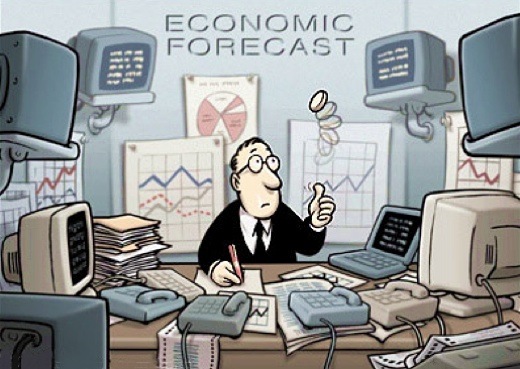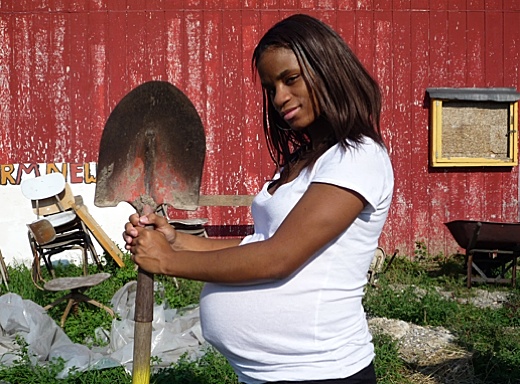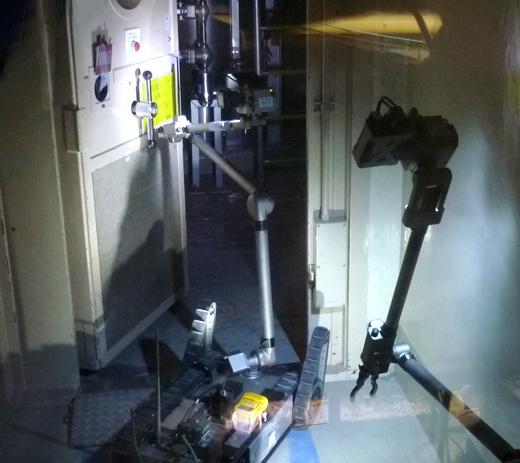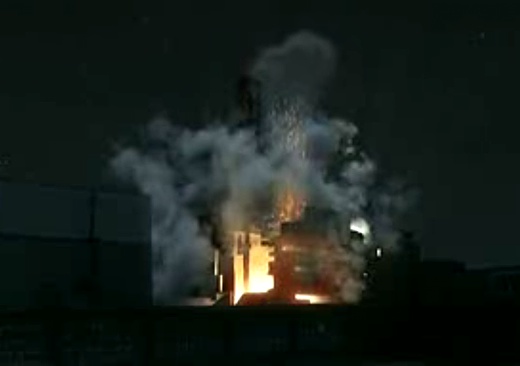SUBHEAD: Who is right? The economists of the American public?
By Raul Ilargi Meijer on 30 April 2011 for The Automatic Earth -
(http://theautomaticearth.blogspot.com/2011/04/april-29-2011-whos-right-americans-or.html)
 Image above: Cartoon by Clay Bennett on economic forecasting. From (http://filipspagnoli.wordpress.com/2009/09/15/the-recession-the-economics-profession-and-the-prediction-of-the-future).
Image above: Cartoon by Clay Bennett on economic forecasting. From (http://filipspagnoli.wordpress.com/2009/09/15/the-recession-the-economics-profession-and-the-prediction-of-the-future).
There appears to be a huge gap between how Americans see the US economy, and how economists do. Indeed, there is such a widening chasm between the two that one could be inclined to think they can't both be taken seriously at the same time.
An April 20-23
Gallup poll, released April 28, indicates that a full 71%(!) of Americans see the economy as either slowing (16%), in a recession (26%), or even in a depression (29%). Only 27% think the economy is growing.
Gallup compares the numbers to those of February and September of 2008, and concludes that today more people think the economy is growing, but that seems a Pyrrhic victory, since the differences are not that great when you look at numbers of people who picked depression or recession:
In February 2008, it was 45%, in September 2008 69% and today 55%. In other words, those who feel the economy is in real trouble, not just a little bit, is still well over 50%.
And we have to see that in the light of the fact that many, if not most, would have trouble defining what exactly a recession or depression is, and would therefore be more likely to just fill in "slowing".
Hence, a vast majority of 71%, well over two-thirds of Americans, think the economy is in the doghouse. But most of all, we need to realize that since 2008, over the past 2,5 to 3 years, untold trillions of dollars have been spent, in taxpayer money, to allegedly "save" and/or "lift" the economy. And this is the result.....
If US party politics is your thing (it definitely ain't mine), Gallup also dove into differences there. And even though 42% of Democrats see a growing economy, vs only 14% of Republicans, what strikes me is that even among Democrats, a 56% majority "voted" either slowing, recession or depression, against a giant 86% of Republicans.
Somewhat curiously, the richest echelon is almost on par with the average American, with 69% saying either slowing, recession or depression.
Now contrast all of this, for a moment, with this week’s Federal Open Market Committee (FOMC) statement that "the economic recovery is proceeding at a moderate pace" (already one notch down from last month's "firmer footing").
Then contrast it with an Associated Press survey of 42 "leading" economists (which was done prior to this week's GDP numbers). And allow me some "live" commentary.
AP survey: Only oil shock can stop economy now
The American economy is now strong enough to withstand Middle East turmoil and the Japanese nuclear crisis. Only a big rise in the price of oil could stop it now. Those are the findings of an Associated Press survey of leading economists, who are increasingly confident in a recovery that is nearly two years old.
They expect the economy to grow faster every quarter this year. In part, that's because the economists think Americans will spend more freely in the coming months.
Sorry, can't help you there. Here's what Lucia Mutikani for Reuters said about yesterday's GDP report:
US GDP growth slows to 1.8%, surprise jump in jobless rate
Growth in the first quarter was curtailed by a sharp pull back in consumer spending.
Clear enough, methinks. Back to the AP survey:
Higher stock prices have made people wealthier. [..]
Well, actually, as we saw earlier this month in this Bloomberg graph below, stock prices make less and less people wealthier. According to Gallup,
just 54% of Americans own stocks, the lowest percentage since at least 1999. Ironically, 69% of Americans still claim
now is a good time to buy a home. Joe and Jane Main Street still have a ways to go towards enlightenment. They clearly see a problem, but by no means all of it.

Less trading and higher prices. The free market laws of supply and demand are broken and violated on a routine basis. And maybe the average American has clued into that more than anyone wishes to acknowledge. Maybe Joe and Jane can still smell a rat even if they can't see it.
If you still need proof, here, again, is a graph that Mike Maloney dug up at the St. Louis Fed website, and that makes it very obvious how markets are manipulated:
Consumer (Individual) Loans at All Commercial Banks - 6 years
My comment then:
Apparently, sometime in early 2010 American consumers, virtually overnight, decided to take out 50% more in loans than they already owed. And the banks let them. Right..
Between the two graphs, I think it should be abundantly clear that Joe and Jane do not profit from the market manipulation their taxes are spent on. Yes, higher stock prices have made
some people wealthier, that much is obvious. But that's only because the markets they are traded in are being heavily manipulated, using Joe and Jane's money
against their own best interest, and even against America's very own real economy.
Back to the survey:
The AP survey collected the views of 42 private, corporate and academic economists on a range of indicators. Among their forecasts:
• The economy will grow at a 3.2 percent annual rate in this quarter, then 3.4 percent from July through September and 3.5 percent from October to December. That would be stronger than the expected 2.2 percent pace for the first quarter.
As we saw, the first quarter just came in at a lowered 1.8%. We would need one helluvan improvement to get to 3.2% annualized. Keep dreaming.
• Employers will hire more. The unemployment rate, now 8.8 percent, will drop to 8.4 percent by December. That's more optimistic than the economists' view three months ago, when they predicted unemployment would be 8.9 percent by year's end. The economists think employers will create 2.1 million jobs this year, more than double last year's 940,000.
Initial jobless claims were up Thursday, at 429.000. Then again, what could ironically help lower the unemployment rate is the fact that
One Million Americans Exhausted All Jobless Benefits in the Past Year. Very conveniently, official statistics now don’t have to count -most of- them anymore as unemployed. According to an April 19 Gallup poll, US unemployment fell to 9.6%, but
underemployment rose to 19.2%. Between the underemployed and the 99'ers, we're looking at a truckload and a half full of people who have an awfully hard time paying their daily bills. Added together, that's easily and at the very least 25% of working-age Americans. Include their dependents, and you're eerily close to your run-of-the-mill third world country.
• Average hourly pay, which has not increased fast enough over the past year to keep up with inflation, will rise. A majority of economists think pay will consistently exceed inflation beginning next year at the latest.
We get into dream territory again. Wonder what these guys base their predictions on. Seeing that for instance
McDonald's just hired 62,000 people, a rise in average wages seems highly unlikely. Very highly. The trend towards lower paid work, if any is available, continues unabated. I’ll flip your burger if you’ll flip mine. As for benefits, you're pulling my finger, right?
• Consumer spending will grow 2.8 percent this year. That's a bit weaker than economists predicted three months ago. But it's more than last year's 1.7 percent increase, when many Americans were still feeling the effects of the recession. The downturn wiped out $7 trillion in wealth and eliminated 7.5 million jobs.
Yeah, sure. We already saw above that it was the very
"sharp pull back in consumer spending" that dragged down GDP.
And really, with un(der)employment where it is, and with
home prices down another 1.1% in February, we get back to what remains the one biggest undisputed truth we’ve often cited here about the American economy (even if some pundits and experts blame the weather for the recent "disappointing" numbers): With un(der)employment numbers as high as they presently are, and with a housing market still mired in the doldrums and sinking further, an economic recovery in America is simply not possible.
Unemployment will need to go down to 5-6%, and underemployment to 10% or so, because if they don't, you lose far too large a segment of your consumer potential to lay any kind of foundation under that recovery, let alone a solid one.
As for housing, the problem is even way more complicated. Real estate prices will need to fall more, and a lot, to make homes affordable again in a time of greatly reduced credit availability, but that same fall in prices will hammer Americans' wealth and consumer spending like there's no tomorrow, which will reduce available credit even more, which will further lower real estate prices and so on and so forth. There is no way to avoid going through this process, called deleveraging. None.
Relatively high home prices mean lower sales figures, since very few people can afford to buy a home, even if they can get credit (think for a moment of those 26,000 new McDonald's employees).
Still, by the same token, relatively lower home prices mean large scale wealth destruction, even if that wealth is by now mainly virtual, and therefore a strong downward pull on consumer spending.
When in the past I have talked about zombie money, it was mostly in connection with large financial institutions and the toxic assets they are allowed to hold in their vaults at 100 cents on the dollar, thanks to FASB 157 fantasy -or zombie- accounting.
But of course zombie money exists on a much wider -though not necessarily larger- scale.
Everyone who today holds assets, such as real estate, or stocks, or yes, even gold and silver, will at some point need to acknowledge that the perceived value of what they hold has been hugely propped up by the government's refusal to mark assets to market.
That is as true for your assets as it is for those held by the banks. The difference is that these banks have received trillions of dollars of your money in order to make the zombie accounting look at least somewhat credible for a while, while the same government that handed them your funds, has left you to your own means. That is to say, your own means minus what it gave away to the banks.
That part you will need to subtract from whatever it is you think you still own, because it's gone and it will never come back. The banks were bankrupt before and they still are; their losses are far greater than the trillions handed to them, which of necessity serve only to perpetuate an illusion for a limited period of time.
There would need to be spectacular economic growth for years into the future in order to just make a dent into everyone’s debt, be they institutions, governments or individuals.
Such growth will not and can not materialize for a long long time if ever. The American economy can't even stand still, let alone grow, without a "healthy" housing market; it's just that big a part of the economy, a home is the biggest asset purchase of their lives for most Americans.
But we have entered a time where prospective buyers can't afford to buy at present prices, and owners can't afford to lose the difference between what they wish their home were worth and what the market will soon tell them it is.
The AP survey piece says:
"The downturn wiped out $7 trillion in wealth and eliminated 7.5 million jobs." I think those are lowball estimates even today. What's more, I don't see any possibility to prevent another $7 trillion in wealth and another 7.5 million jobs being eliminated.
We saw this week that a Greek default, or debt restructuring, or pick your favorite term, will force Greek and/or other European banks to mark at least part of their assets to market. That Greek default is inevitable. The same is true for Ireland, Portugal and Spain, though perhaps not all of them this year. The amount of debt for these countries held by the main European banks, like Deutsche, Crédit Agricole, Société Générale, Santander, the Britsh banks, is huge.
Once a forced mark-to-market of assets starts, entire asset classes will be repriced around the globe, way below where their alleged value now stands. And your assets too will follow that downward move.
Which means that Americans are right to be very somber about their economy, and that the economists AP surveyed are either incompetent or insincere.
.














